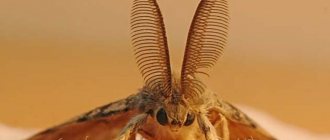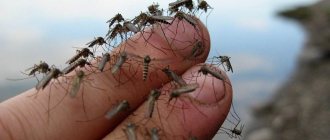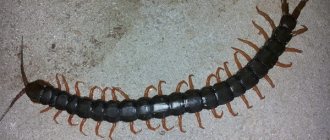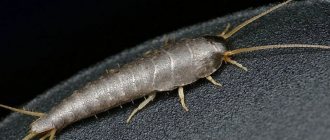The most important thing is what kind of moth is in the house, what type it belongs to - there are clothes moths and food moths. These pests, similar to each other, but completely different in their biology, each enter the house in their own ways.
Important!
When wondering where moths come from in an apartment, it is useful to remember that they do not care about the sanitary condition of the room. The pest equally effectively infects unhygienic barracks and luxury housing. The main thing for her is the availability of food supply, and it is this food supply that is most abundant in expensive houses.
What is
A moth is an insect belonging to the order of butterflies. The size and appearance of an individual depends on its species. House moths usually include clothes moths, furniture moths, grain moths and food moths. All of their adult representatives are small in size (up to 15 mm) and unsightly in color, for example, gray-green, dirty brown. The insect lives not only indoors, but also in nature. For example, there are cabbage, apple, and rye moths.
The feeding method of individuals also varies greatly. All larvae and caterpillars, thanks to their powerful mouthparts, can eat tough and hard food: stems and leaves, nuts, cereals, cabbage, beets. All moth species have their own favorite food, and it is often reflected in the name of the species. In addition, in some varieties, the adult does not have a mouthpart and cannot feed, and therefore lives no more than a week.
These pests live near or directly in a food source, for example, in cereals, cabbage, or on an apple tree. At first, a small nest always appears, where all the larvae live compactly. Nests are also within reach of food.
Signs of infection
Signs of the presence of moths
You can learn about the existence of moths in an apartment by fluttering butterflies and caterpillars. Moths are active in the dark and often appear in the evening. During the day, moths hide in dark places, away from bright sunlight. If the apartment is heavily infested, moths can be found during the day, and not only in the room where the larvae are parasitizing.
The second obvious sign is caterpillars. Periodically, they crawl out of infected cereals and travel around the apartment. You can meet them in the kitchen, bedroom, living room. The caterpillars develop from 1 to 2 months, at the last stage they reach a size of 1.5 cm and pupate. After a few days, sexually mature adults emerge and immediately begin mating and laying eggs. In 14 days, one female is capable of laying about 100 eggs.
Contaminated products look disgusting, disgusting, terrifying. In one place there are caterpillars of different sizes, excrement, moths, pupae, and cobwebs. Such a sight is found even in hermetically sealed cereals - in bags.
On a note!
Food moths never attack fur products, and clothing moths do not grow in cereals. But to prevent re-infection, general cleaning should be carried out throughout the apartment.
Causes of infestation of premises with food moths
It is unlikely that you will be able to completely insure yourself against the appearance of food moths in your apartment, because to infect the kitchen, one larva that has flown into an individual or one larva in packaged cereal is enough. It is much more important to create conditions at home that will not allow moths to comfortably multiply and spoil food.
First, let's see what conditions are most favorable for food moths:
- Feed. Without food, the moth simply cannot reproduce, so it always needs a source of food: boxes of cereal, bags of flour and nuts, or at least dried herbs.
- Convenient place to live. The moth prefers lockable kitchen cabinets and pantries, where it can live and feed at the same time. It is almost impossible to detect food moths on open kitchen shelves - they avoid light.
- Lack of ventilation and twilight. The moth does not tolerate fresh air and direct sunlight, preferring enclosed spaces where food is stored.
- No pungent odors. There are aromas that moths find very unpleasant and cause them to move away from their source. These include the smell of citrus fruits, lavender, eucalyptus, tobacco, vinegar.
What to do if moths appear in the apartment
Found a pest? Don't panic! After reading the instructions below, you will learn how to get rid of moths in your apartment:
- Regardless of what type of moth is in your home, you need to inspect the entire room. She doesn't like light, so pay special attention to cabinets and drawers. View all containers, bags and bags of cereals. Moths do not like strong odors, and in these places the best conditions have been created for their existence. We advise you to inspect dressers with clothes and shelves with books for larvae and already adult individuals. Remember that moths will not settle alone;
- found a nest with larvae? Use a vacuum cleaner to remove the contaminated area and wipe the area with a solution of a combination of water, detergent and a small amount of chlorine;
- If moths have settled in the closet, then first carefully treat the clothes with a steamer. Next, wash the items in a washing machine at a temperature not lower than 60°C, and treat the closet with the solution we wrote about in the previous paragraph;
- Place wool and fur items in the freezer for 2-3 hours. The larvae will not survive in such conditions;
- You can clean outer clothing from larvae yourself using a brush and the same steamer. Pay special attention to folds, pockets and lining. After completing the steps, take the clothes to the dry cleaner;
- treat all carpets, furniture and curtains in the apartment;
- Kitchen moths can be found in drawers. Carefully inspect bags of cereals, bread products and other bulk products. Remember, under no circumstances should you eat contaminated food! Throw everything in the trash bin, don't be sorry. After this, treat the cabinets and drawers with a bleach or vinegar solution.
You have completed the first steps to get rid of the pest. But what to do if the moth begins to actively reproduce again?
How to fight
You can get rid of moths at home only by finding their lair and destroying all the eggs and larvae. In addition, the butterflies will need to be destroyed so that they cannot lay new eggs. For these purposes, it is necessary to use all possible methods of control, namely: chemical, physical and folk methods. Of course, chemicals are always more effective, so you need to start with them.
Chemicals
Modern insecticides will help remove these pests. They are available in the form of aerosols, fumigators and sections. The first act quickly, the second - slowly, but protect better, the third - only protect.
Aerosols.
The use of aerosols in the fight against moths is very labor-intensive. To completely destroy these pests, you need to spray not only infected items, but also all surfaces in closets, carpets, and upholstery. One can will not be enough for this. After treatment, 3-4 hours later, you will need to thoroughly wash the room, ventilate it and wash the disinfected items.
The use of aerosols against kitchen moths is completely limited. They can be used to poison flying species, including butterflies. But the use of aerosols against larvae in cereals and food storage areas is prohibited, since the products will be poisoned and unsuitable for consumption in this case.
The best aerosols are:
- "Armol".
Ideal for fur and wool products. Smells like lavender. It costs about 70 rubles. - "Raptor".
Effectively destroys insects at all stages of its development. Smells like lavender. The residual effect lasts up to a year. A bottle will cost 90 rubles. - Mosquitall "Protection against moths".
A very powerful product with a lavender scent. Suitable for processing fabrics, furniture and clothing. 200 ml of the drug costs about 100 rubles. - "Clean house".
Like other aerosols, it is highly effective and has a lavender scent. In addition, “Clean House” is used very economically.
Fumigators.
To combat moths, they are used much less frequently than aerosols. However, using them is very simple: you need to place a plate or flask with liquid in the device and plug the device into a power outlet. When heated, it begins to emit an odor that is detrimental to the insect. This aroma does not bother a person at all and is even imperceptible to him.
For baiting moths, the same fumigators are suitable as for mosquitoes:
- "DiK-3".
This device costs about 30 rubles and effectively copes with pests. Suitable for fighting kitchen and clothes moths, however, you should not place it near food. - "Raid".
An analogue of the DiK-3 device, but its cost is many times higher - 120 rubles for the device and 10 plates for it. - "Mosquitall".
Like other fumigators, this device is equally effective against moths and mosquitoes. Its action is enough for a room of 30 square meters. m.
Mothproof sections.
This type of chemicals against these pests is also in demand. Their action is aimed at scaring away butterflies, however, the larvae that have settled nearby remain safe and sound. Therefore, the use of this remedy is more of a preventative measure than a control method.
- "Raptor".
Sections of this brand are very common among buyers. Their aroma is different. For proper protection, you need to hang 2 sections per cabinet. Their effectiveness period is estimated at 4 months. - "Mosquitall".
These sections come in two types: plates or bags hung on a hanger, or blocks glued to the surface of the cabinet. Their cost varies from 50 to 120 rubles.
Physical means
You can destroy moths without using chemicals, namely:
- To begin with, you should always find the insect nest and remove it, for example, vacuum the shelves.
- For butterflies, fly-catching tape should be used.
- If there are moths in the cereal, you can bake it in the oven for 30 minutes at 60 degrees.
Folk recipes
Moths, like other insect pests, cannot tolerate the odors of certain plants. These include lavender, citrus fruits, tobacco, and geranium. Using these herbs, you can scare it away for a long time. Among the means available to a person at home that can destroy moths is naphthalene. However, recently its use at home is not recommended.
A universal method of prevention
There is one universal folk recipe for getting rid of moths in an apartment. But it rather prevents the appearance of the pest than actually destroys it.
- Dried lavender, tobacco, and citrus peels are placed in a small bag made of thin fabric, or preferably gauze.
- It is then placed in a closet with clothes or food.
- The contents of the bag should be changed once a month as the smell fades.
Calling specialists
Unlike ordinary people, only professionals know how to get rid of moths quickly and effectively. In addition, they always provide a long-term guarantee on their services. It is recommended to contact the parasite control service for those who do not have the time and desire to fight on their own, or the infestation is too strong. Specialists will competently select the product and carry out thorough processing.
A little about the pest
Origin of the species
Moths belong to the order Lepidoptera (that is, butterflies), which are characterized by being nocturnal. These are a very unassuming species of moths, which are usually no more than 1 cm in length. Traditionally, they are distinguished by their pale color with small patches on the wings, and most often they are gray or even brown in color. There are even a number of varieties of this family of insects, but in this review I would like to consider only two species that people most often encounter at home.
The most popular guests of our human abode can rightfully be called food and paid moths. Such butterflies can be distinguished by several differences in the color of their wings. Wool moths (that is, clothes moths) have a more golden color in their faded appearance, while grain (that is, food) moths are always gray in color and are distinguished by the presence of brown wings.
As you can guess, to the question of where moths appear in a home, it is impossible to give an unambiguous affirmative answer, which will also be unbranched, because for each mentioned variety the reasons for the appearance can be very different, taking into account their diametrically opposed food preferences. But still, there is something that unites such pests in the rooms of our homes in general or specifically in the kitchen. Moths usually appear in an apartment or house in cases where all the prerequisites for its appearance have been created in the form of the presence of an accessible and suitable food supply.
Insect threat
Please note that it is worth immediately noting the fact that the direct threat to provisions and wardrobe items will be posed specifically by the insect larvae, and not by the butterflies themselves. The fact is that adult insects will not feed on food or even fibers of natural origin (here we are talking about clothing), since they do not have an oral gnawing apparatus for this.
Their task will be to lay eggs after mating in the most suitable place for the development of larvae. But the larvae will represent the nutritional stage of the insect’s development, and this will indicate complete gluttony and focus on food consumption, as well as a set of required nutrients for pupation. It should be remembered that if a moth butterfly flies in a room or even in the kitchen area and you slam it down, this will not guarantee that all problems will go away with adult individuals. The eggs may already be lying around, and checking for their presence in the house will not be superfluous. Next, we propose to take a closer look at what exactly can cause this or that type of almost invisible, but at the same time very harmful insects to appear in the house.
How clothes moths get into an apartment
So, where do moths come from in the closet if all things are new, clean and neatly folded? To find out, you should remember whether you purchased the following products recently:
- natural wool carpets
- furniture with natural upholstery
- outerwear made of fur or wool
- wearable woolen or knitted items
- shoes with natural fur.
It is also useful to read: Why does a moth lack a proboscis - isn’t it a butterfly?
If moths appeared at home after one of these purchases, then we can say with confidence that the larvae were already in it at the time of purchase. After settling in, the moth began to multiply and spoil other things that came in its path. Unfortunately, the pest can even be in expensive items from trusted stores that protect their reputation.
Store-bought or used furniture can also serve as an excellent “vehicle” for transporting moth larvae to a new place of residence. This is especially true for old furniture, in which it is very easy to get to the “tasty” filler.
Clothes moths can choose a more exotic way of entering the house - on the fur of pets. In principle, moths do not parasitize living creatures, but they can very well use their fur as a temporary shelter. Cases when moths appear in this way are quite rare, and only adult moths can settle in this way and on dogs with long, shaggy hair - bobtails, giant schnauzers, wire-haired dachshunds, South Russian shepherd dogs.
Listed above are the main ways in which clothes and food moths appear in a person’s home. But whatever the method of its penetration, it is important to prevent the parasite from multiplying throughout the apartment.
Where do clothes moths come from?
What causes moths to start in an apartment is something everyone should know, because sometimes even the most neat, ironed and cleaned things turn out to be infected with this scourge. A butterfly or eggs can get into your home in a variety of ways. If a person suddenly develops furniture moths, this probably happened after purchasing furniture - sometimes even new.
In carpets made of natural wool, these insects also migrate to the new owner straight from the store. Fur items stored in stores for a long time may also be infected with the parasite. It is not difficult to understand that you can expect tricks even more often from worn clothes or other items that are not new.
In addition to the indicated paths, there are other directions where moths in the house come from:
- A butterfly may accidentally fly into an open window. Further reproduction of butterflies is possible if such an individual turns out to be a female. Usually the insect flies outside in the evening in the summer, so it is recommended to have mosquito nets on the windows.
- Insects often fly in through doors. They hide in the entrance, waiting for the right moment to enter the owner’s home. This happens more often in the evening - when the door opens, butterflies fly into the light.
- Moths can also enter the house from neighbors through ventilation. Therefore, ventilation grilles must be strong, undamaged, and cleaned regularly.
- Occasionally, if there is a moth infestation, this is due to the introduction of its eggs from the fur of dogs. This is possible when the pet belongs to a long-haired breed. Butterflies can lay eggs on animals as temporary housing, and if purchased, in addition to the dog, the owner will become the owner of harmful insects.
Help: It is a mistake to think that butterflies and their caterpillars breed when sanitary standards are not observed, in dirty, uncleaned rooms. The reasons why moths appear are not related to dirt and dust - these parasitic insects only need suitable food.
Prevention
It is more difficult to remove moths from an apartment than to prevent its appearance. Today, ready-made sections against these pests are produced for the laziest. They do not use chemicals, but only natural oils, the smell of which is unpleasant to insects. To avoid encountering food moths, you should carefully examine the purchased cereals for contamination. For the first time after purchase, it is better to leave them in the original packaging to make sure there are no pests.
Source
Traditional methods
Traditional methods, although quite effective, do not work very quickly. They are best used as preventive measures. These include various herbs that repel adults with their aroma. They do not affect the larvae. Mothballs were often used for things. It is effective, but things acquire an unpleasant aroma.
Bags with lavender for moths.
There is one proven folk method - shaking it up. The insect does not like disturbances and changes in climate conditions. Therefore, at the first suspicion of infection, you need to shake up all deposits of rags. Natural furs and coats should be carefully inspected and checked for damage. In summer you will need to put it in the sun, and in winter in the cold.
Moth - types of butterflies
There are several types of moths that literally distribute “spheres of influence” in a person’s apartment. All of them are divided into two groups - food moths and clothes moths. As the name suggests, some butterflies parasitize on food, while others parasitize on the host’s things and clothes. The following types of moths are distinguished:
- Fur coat. The yellowish butterfly itself, up to 1.6 cm in size, does not harm humans, since it does not eat anything. Its main goal is to lay several clutches of eggs, from which voracious larvae emerge. Outwardly, they resemble worms and have a white translucent color. Worms eat the fur of fur coats, hats, collars, and gnaw holes in them. In a matter of days, the fur turns into a sieve.
- Clothes. The size of the butterfly is up to 2 cm, its wings are yellow and purple at the base. The caterpillars look the same as those of the fur moth, but they settle in the folds of various fabrics and clothes with wool. The butterfly lays its eggs directly on the inside of the fabric, and after the caterpillars hatch, they immediately begin to feed.
- Furniture. In the house, she begins to lay eggs on the upholstery of furniture, as well as in the cracks of wood. The caterpillars eat the upholstery and then move onto the wood. The butterfly is small, up to a centimeter with a wingspan, light yellow in color with brown wing bases.
- Carpet. The larvae of this butterfly eat carpets, fur, and even leather products - bags, boots. This moth almost does not react to standard means - camphor and naphthalene - so it can sometimes be difficult to remove it.
Attention: An untrained person cannot distinguish a food moth from a clothes moth, but there is a big difference between them. This type of butterfly lays eggs directly into food products - nuts, cereals, flour, and the larvae intensively eat them.
Varieties of moths in the house
Some people still think that such an insect can only settle in housing where there is complete unsanitary conditions. Of course, this is a misconception. Moths can grow in both a dirty barn and an elite house.
Before starting the fight, it is necessary to determine the type of insect, since all “military” tactics will depend on this. Below we will consider the types of moths most often found in our area. These are food and clothes moths.
Clothes moths live in things. Its eggs can be found in furs, wool, carpets, wood cracks, boots and leather bags. When a caterpillar appears in this world, it begins to actively feed, and then our things suffer the most. Such insects have a well-developed mouthparts, so they can ruin even very thick tissue.
A month will pass and the larva will become a pupa, and after a while a butterfly will fly in your house, which will immediately begin laying eggs. Over the course of its entire life, a moth lays about 200 eggs.
The food moth is not interested in clothes; it is attracted to cereals, nuts, seeds, grass, flour, dried berries and fruits; in general, its place of residence is the kitchen. So, she hides in dark cabinets and food packages.
Where do moths come from in an apartment and how to get rid of their larvae?
Fighting methods
It’s not enough to know where moths come from in the house. You need to know how to deal with the harmful moth that destroys groceries and things. There are several control methods, the most effective of which is chemical. It involves the use of insecticides. True, this method is applicable only if we are not talking about food moths. It is forbidden to treat groceries with toxic preparations.
As for the choice of insecticide, a wide range of drugs is available on store shelves today. The first thing you need to pay attention to is the toxicity class. In residential premises, it is advisable to use low-toxic drugs, which, as a rule, are not cheap. But, as for pricing policy, any good pesticide will not be cheap. Cheap insecticides, as practice shows, are ineffective. It is also worth paying attention to the presence of odor. Preference should be given to odorless insecticides, which are difficult to remove from the house after treatment.
The next group of methods are biological. These methods involve exposing the moth to high or low temperatures. The butterfly dies at temperatures exceeding 600 C or below -200 C. Therefore, things can be washed at the desired temperature, or better yet, boiled, or taken out into the cold. As for groceries, they can be processed at high temperature in the oven.
Damage caused by butterflies
Gray and brown butterflies that appear in the house in winter and summer cause significant damage. Various types of pests appear in the apartment, each of which consumes a specific product. Based on taste preferences, it is easier to determine how the parasite appears and how serious damage it can cause.
The food type destroys all supplies stored in kitchen units and cabinets. If it was not possible to quickly find out where the food moth comes from, then its caterpillars will destroy all food supplies. The oral apparatus of food larvae is well developed. Therefore, they easily chew through polyethylene, plastic and cardboard packaging. The gray butterfly uses containers and bags with grains to form a clutch. The number of clutches depends on the degree of infection in the kitchen.
Clothes pests cause more damage because they damage expensive wardrobe items. They consume fur fibers and wool products. It will take 2-3 days for a bald spot to form in a cashmere coat. Eliminating the consequences of the attack is problematic. Some things simply cannot be restored. Pests not only spoil the pile, but also leave sticky marks. If you don’t know how to remove emerging insects, the damage can be serious.
Brief description of the family
Moths are insects closely related to butterflies, although they are not actually butterflies, except as a general definition, to which the term "moth" also applies. Meanwhile, both moths and butterflies belong to the same order of Lepidoptera, and this is where their similarities end. There are more differences between butterflies and moths than just dry entomological taxonomy. To date, researchers have identified about 200 thousand species of butterflies around the world, and we can say for sure that there are at least five times more known representatives among moths.
All species are characterized by a general structure of the body and vital processes. The antennae of moths, as a rule, are shorter than those of butterflies, and along their length you can find shaggy “branching”, strongly reminiscent of frost on wires. When the insect sits, it folds its wings evenly, giving its body a narrow, flat shape. An exception may be several species that keep their wings unfolded at rest. The size of moths of different species can vary greatly - from a few millimeters to several centimeters.
These insects typically have thick, hairy bodies ranging in color from golden yellow to dark brown. Some species are characterized by a radical black color. The vast majority are active at night and rest during daylight hours in a preferably shady habitat.
What to do if there are moths in the closet with clothes
Moth in the closet.
If there are wool or fur moths in your closet, action must be taken immediately.
All things from the closet should be taken out into fresh air. You need to carefully inspect the clothes. Shake scarves, jackets, sweaters, knitted hats well, then wash and dry in the sun.
Most often, nests are found in winter clothes put away for the summer. Thoroughly brush fur coats, coats, fur hats, jackets lined with fur, paying close attention to seams, cuff turns, folds and darts. After cleaning, hang the items in the sun all day.
While the clothes are drying and airing, you need to clean the closets. Internal surfaces should be thoroughly wiped with a sponge and laundry soap (72%), and then treated with vinegar (9%) - especially carefully in the corners of the bottom and shelves.
Before returning things to their place, it is necessary to treat them with products approved for use at home: “Raptor Moth Protection”, “Raid” or “Mosquitobreaker”. These products help eliminate the pest the first time.
Until recently, mothballs were placed in closets with winter clothes to kill lepidopteran butterflies. This is an effective drug, but dangerous for humans and animals.
What to put in the closet
To remove the pest forever and prevent re-infection, after cleaning you need to put one of the following products in the closet:
- “Clean House” moth balls;
- Raptor traps;
- “Stop Mol” records;
- fresh or dried bunches of lavender;
- cotton pads soaked in fir or lavender oil;
- cedar bark;
- sprigs of geranium;
- dried tobacco leaves or packaged chopped tobacco;
- bags of ground cloves (spice);
- orange peels, laurel leaves (in kitchen cabinets - against barn moths).
The validity period of chemicals is indicated in the instructions. Folk remedies should be replaced with fresh ones 1-2 times every six months (as the smell is lost).
If none of the listed remedies are at hand, you can use a proven folk method. Sew a small bag from canvas or other dense natural fabric. Prepare a saline hypertonic solution.
To prepare it, take enough salt so that a fresh raw egg, immersed in salt water, floats to the surface. Boil the bag in the solution for 1-3 minutes and hang to dry (without squeezing). Place wool and fur items for summer storage in a dried bag and tie it tightly.
Professional ways to fight moths
Getting rid of annoying insects is more difficult than you might imagine. Here are several ways to remove moths from an apartment:
- A win-win option is to call a disinfection service. Within an hour, specialists will process the entire room. The preparations used are odorless and safe for adults and children, animals and plants. Within 2 hours after treatment you can return to your apartment. A specialist will tell you all the nuances of the procedure. The cost of this service depends on your city;
- In household chemical stores you can find many aerosols and sprays that are good for dealing with both larvae and adults. When purchasing, carefully read the information on the can, because not all aerosols are intended for spraying in the kitchen. It is necessary to process the room only while wearing a mask. You will need to leave the apartment for several hours after treatment, and then do general cleaning and laundry. List of some popular aerosols: Dichlorvos, Raptor, Antimol and Armol;
- fumigator - a small device with a plate or liquid that operates from an outlet. When heated, toxic fumes spread throughout the apartment and destroy flying insects. Manufacturers note that the fumigator is safe for people and animals. The disadvantage of its use is that it affects a small area in the apartment;
- Another effective and most harmless remedy against moths is traps. This is a small box that emits the subtle scent of female pheromones. The male will simply stick to the box, so they will no longer be able to produce offspring. The main thing is not to overdo it with the placement of traps, since due to their large number the male may lose orientation in space.
Preventing moths
Unfortunately, it will not be possible to get rid of moths forever. If you have successfully overcome an insect, this does not mean that it will not come to your home again.
Don't rush to get upset! You should be vigilant, so just carry out preventive maintenance regularly. The procedure does not take much time. It's easier to prevent a problem than to deal with it later, isn't it? Here are a few ways to help prevent moths from appearing in your apartment:
- do not hesitate to inspect items in stores, even if you purchase a mink coat in an expensive boutique. The goods are stored in warehouses where moths actively breed. Remember that the best conditions for it are twilight and dampness. Check all folds, pockets, linings, and carefully inspect packages of cereals, herbs and other products. Make a choice in favor of purchasing goods in factory sealed packaging rather than in bulk;
- When purchasing used furniture and wardrobe items, disinfect them before bringing them into the apartment. Moths prefer old things and unwashed clothes that have pieces of human epidermis on them;
- Ventilate the apartment more often, shake out blankets and pillows;
- Place sprigs of lavender, wormwood, citrus peels or garlic in closets with clothes and food. Moths also do not like the smells of tobacco and eucalyptus. You can use essential oils by dropping a small amount onto a cotton pad or gauze;
- periodically dry small wool items on the radiator, and take outer clothing to the balcony;
- Store food in the kitchen in containers rather than in factory packaging. Throw away spoiled cereals immediately;
- Regularly wipe kitchen units and cabinets with vinegar solution;
- Before putting warm clothes away in the closet for the summer season, treat them with moth spray. Place crumpled newspapers in the pockets of your outerwear - the pest does not like the smell of the printing house;
- Another excellent remedy for moths in the closet is a ready-made pendant with a pleasant aroma that will repel insects. For example, Raptor or Raid brands. You can buy it at hardware stores.
Now you know where moths come from in an apartment and what means will help remove them. If you follow all the recommendations, you will not encounter moths! And if, nevertheless, uninvited guests settled in your apartment, then thanks to this article you will quickly get rid of them.
Share, did you learn anything new from our article? What recommendations were helpful to you?
A sign if there are moths in the house
In ancient times, the golden fluttering pest did not evoke good feelings among the population and its appearance was associated mainly with negative consequences. This was more than reasonable, since it started up mainly in spoiled food and dark, poorly ventilated rooms.
She was considered a harbinger:
- Unexpected cash costs. This followed from the fact that with the appearance of moths it was necessary to get rid of one of the few items of clothing or part of the winter supplies.
- A pale “butterfly” fluttering around the house was also a symbol of the inattention and aggression of one of the family members towards the others. With her appearance, they tried to bring a brawler or a heartless person to reason while there was still a chance to avoid a split in the relationship.
- A sudden and numerous invasion of moths was associated with the influence of dark forces or astral entities from the other world. It was believed that they were directed by enemies or envious people.
- The white moth was also a sad symbol. People believed that in the form of a moth the soul of the deceased returned home to visit his relatives. It was strictly forbidden to kill her, so as not to cause additional suffering to the soul of a loved one.
- If a moth appears suddenly and you cannot get rid of it, it means that the dark aspects of the consciousness of someone in the household have been activated. Small aspects of behavior could completely cross out all bright desires and aspirations.
- The appearance of a tiny fluttering pest could be evidence of magical damage being done, damage to the subconscious, which will only make itself felt if something extraordinary happens.
- If you come face to face with a moth, it means a letter will arrive soon.
What harm does it cause?
If there are moths in the house, this can lead to significant losses. Products affected by this pest become unsuitable for food. During their life, the larvae leave scales, droppings, and pieces of cobwebs in them.
Clothes moths are no less dangerous. Of course, she is not capable of completely destroying a sweater, fur coat or carpet, but she is quite capable of ruining the presentation of the item forever. One larva can make a hole through a sweater made of natural threads in a day.
general characteristics
The insect looks like a small butterfly; there is no bright color or external distinctive features. The color of the pest depends on its habitat in order to better camouflage itself. Adults differ from butterflies in the absence of a proboscis. The moth does not feed on anything. It replenishes its energy reserves from accumulated substances while being a caterpillar. Its main task is reproduction. Moths do not harm humans.
They also leave excrement where they live. Adult pests are afraid of sunlight. Therefore, their place of residence is hidden and dark places.
We suggest you read: How to make a tincture from wax moth
How to find a mole?
When the insect reaches normal size for an adult, its activity increases sharply. The pest begins to fly relatively long distances. Narrow openings and cracks do not become an obstacle for moths. Pregnant females fly poorly, so males most often do this.
To find moths, you should look in the folds of clothing where they lay their eggs. The moth prefers to lay eggs in a moist environment. You can find the insect in containers or bags filled with cereals. The risk of this increases if products are stored in basements. Moths often hide in rolled carpets, fur items and folded blankets.
What do moths eat?
If moths appeared in food, where did they get there? Food moths spoil groceries: cereals, flour, pasta and bakery products. She does not disdain seeds, nuts, dried fruits and berries, and also loves cookies, chocolate, and candies.
Clothes moths eat any products containing natural fiber. She can appear in closets with clothes; she loves woolen things and balls of wool. Often the pest spoils clothes that are put away for storage without pre-washing. There are a lot of epidermal particles on such things, and this attracts caterpillars. The discovered gray moth itself does not pose a danger; it is its offspring that cause harm.
In an effort to get to their cherished goal, moths are capable of chewing through polyethylene, so it is useless to put winter clothes in bags.
Types of flying insects
Household moth is a general term for all varieties of insects that can get into an apartment and ruin your favorite clothes and groceries. They differ in their feeding habits and external characteristics. There are six types.
- Clothes moth. Light yellow butterfly with a lilac tint on the wings. The larvae of the parasite are white, with powerful jaws, and feed on soiled areas of clothing, gnawing them to holes.
- Fur moth. A white moth with black spots on its wings. Caterpillars eat products made of fur, velvet and wool. Standard cellophane clothing bags do not pose a barrier for them.
- Furniture moth. Butterfly with yellow-gray wings. The larvae eat sofa upholstery and fur items. They live inside furniture or in closets.
- Buffalo bug. The moth is dark brown in color with specks on the wings. Lives in carpeting, gradually eating fluffy pile.
- Wood moth. A small moth that climbs into apartments for the winter.
- Food moth. The butterfly is brown or gray in color, belongs to the moth family, the wingspan does not exceed 15 mm. Lives in the kitchen, eating groceries.
An effective moth repellent
The leaders in the fight against moths are various fumigators. Due to the delayed action, this may not seem to be the case, but their pros far outweigh the cons. They are suitable as a preventative measure because they do not require constant monitoring or any effort on the part of a person. It is enough to turn them on in a room where a potential carrier of moth larvae will soon appear, and you can forget about them.
The fumigator can be used for a very long time - from several weeks to several months. When it runs out, you just need to change the wick and reuse it. Neither folk remedies nor Velcro sprays are designed for reuse.
Due to the extended exposure to moths, fumigators release significantly less insecticides into the air than sprays. This allows you to be in the same room with a working fumigator and practically does not lead to an allergic reaction. Fumigators are safe for children and animals, but direct contact with them is best avoided. The most popular fumigators are from Moskitol. A pleasant bonus of using them will be the absence of mosquitoes.
If after all the tricks the moths do not decrease, you should call a team of exterminators. This is the last and extremely radical remedy. Knowing everything about moths, from the ways in which they appear in the house to the variety of methods for getting rid of them, you can clean your apartment in the shortest possible time.
Signs of a pest
Moth larvae on clothes.
There are several visual signs that can help you identify pests in your home. The main one, of course, is the flying adult moths. But they are already an indicator of the spread of a large number of pests.
You can recognize the appearance of moths by small larvae in places where they can be very conveniently located: on the back walls of furniture, kitchen units, in unclosed bags of cereals and in cabinets with furniture. Small eggs are most often securely hidden, and they are almost colorless, so they cannot be identified.
Life cycle
How long moths live, and at what stages of development they pose a danger to your products and things, we’ll talk further. Flying completely nondescript gray butterflies are already safe. These are adults, their lifespan is 2-4 weeks. During this period, the moth multiplies, producing 1-2 clutches of eggs. Females lay eggs in the same place where they feed. There are from 60 to 230 eggs in one clutch. After 12-15 days at a comfortable temperature of 20-25 C°, caterpillars hatch from them. They build cocoons from the nutritious material in which they live and feed here. It is during this period that future butterflies cause harm. It takes up to 45 days for a caterpillar to transform into a butterfly.
It is strictly forbidden to eat foods in which food moths are found. Caterpillars infect the environment with the waste of their own vital activity; there may be dead larvae and skins and cocoons shed by insects.
How to eliminate gray butterflies?
Modern insecticides and traditional methods are used to destroy caterpillars and adults. If the cause of the large moth was determined late, then it is better to use chemicals and special devices to combat it.
- Sprays. Manufacturers produce aerosols to kill insects and protect your wardrobe. Leave the treated premises for 2–4 hours. After this, the apartment is ventilated. If the treatment was carried out in the kitchen, then all surfaces and furniture are washed. If the question arises of what to do when a moth appears, then it is better to use proven sprays and aerosols.
- Standard and gel sections. They are placed in wardrobes and bedside tables. The components used for preparation repel gray butterflies. The substances included in the sections do not affect the condition of the caterpillars. Sections are used if prevention against moths is required.
- Plates, strips and tablets. No toxic components are used for their preparation. Therefore, they are harmless to children, pets and adults. The cost of such drugs is low, so many can purchase them.
- Gel compositions. For production, components and vegetable oils that are unpleasant to pests are used. They are located in containers, which are distributed throughout the room and shelves. It is allowed to use gels to protect wardrobes or kitchen furniture.
- Fumigators. Used for prophylaxis. Modern fumigators are equipped with autonomous power sources. Some models plug into a wall outlet. The devices emit a rich aroma that repels butterflies. The operating time of the fumigator depends on the brand and configuration.
- Vegetation. To repel various pests, lavender, wormwood or citrus fruits are placed on window sills, near ventilation shafts and in kitchen units. The use of extracts and essential oils is allowed.
To protect wardrobe items from pests, it is necessary to take into account information about the routes of penetration. After all, insects are bred only in those rooms in which conditions are suitable for development.
Natural "camouflage"
Nature gave such an inconspicuous color to moths for a reason. First of all, because the earthy shade is an excellent protection and allows you to avoid an unpleasant encounter with a hungry predator. An interesting fact is that representatives of different species of moths living in a particular environment acquire colors in accordance with its conditions. For example, the development of moths of forest species is more characterized by a greenish tint, while others are more characterized by the color of the bark of trees, which are more abundant in this area.
But science has become aware of an even more unique phenomenon, a property that only very few representatives of the insect world can boast of. It has been observed that in urban areas where there is heavy soot pollution, some species of moths actually become darker in color than insects of the same species living in less polluted areas.
Another effective form of camouflage is the shape that the insect takes on when at rest. Species that live primarily in tree crowns, as a rule, do not fold their wings at all in order to be more like dry leaves, while “grass” ones actually extend their wings into a line so that they cannot be distinguished from a blade of grass. Not least important is the flight strategy of the moth.
Few of these species fly straight and slowly. Many of us have observed house moths flying around in such a way that it becomes difficult to catch them. Light excites the insect, forcing it to be even more active, so the closer the light source, for example, a light bulb, the faster the moth will fly and the more chaotic at first glance its direction vector will be, which most often becomes circular.
An effective form of defense that other flying insects could take a few lessons from the moth is mimicry. Mimicry is the ability of a living organism to simulate the appearance of a larger or more threatening creature. This form of defense is used both by caterpillars with tails that look like the large head of a poisonous snake, and by adult individuals, whose war-spotted coloring on the outer surface of their unfolded wings scares off even large birds. Mimicry is also characteristic of some species of butterflies.
How to get rid of moth larvae?
While it is not difficult to get rid of butterflies, methods of fighting caterpillars are more labor-intensive.
Tips for killing food moth larvae in the kitchen:
- Thoroughly vacuum cabinets that have been emptied of food.
- Wash the interior surfaces and dry. Then wipe with a sponge soaked in apple cider vinegar.
- Inspect bags and containers with bulk products.
- If you find clutches or larvae, feel free to get rid of the food. They are toxic and not suitable for cooking.
- If there is no masonry, place the dishes with cereal in the microwave for 5 minutes. Turn on the microwave oven at maximum power. An alternative is to use the oven and freeze the food for a week.
- Wash containers with soap, dry, and wipe with vinegar.
To save clothes from clothes moth larvae, follow these steps:
- remove things from the closet, shake each one;
- get rid of the hopelessly damaged ones;
- take fur coats, coats, fur hats out onto the balcony under the sun’s rays;
- wash bed linen and woolen items for at least half an hour or freeze for 24 hours;
- wash the walls of the wardrobe with a special furniture cleaner, especially carefully - the far dark corners;
- place moth repellent on the shelves - tablets, balls, sections;
Sprays, aerosols, and taking things outside in sunny or frosty weather help destroy larvae on carpets, paths, and furniture.
Traps
Traps are a relatively easy-to-use method that can help detect and reduce clothes moth infestations. Pheromone traps are available in specialty stores and are relatively inexpensive. Pheromones are chemicals produced by the body of a male insect, which in this case is a sex attractant that can influence the behavior of other members of the same species.
The sex pheromone lures females into the trap, where they become stuck on its sticky sides. Since the pheromone specifically attracts only moths, it will not attract other types of insects.
Where do moths come from in the kitchen and how to get rid of them?
The principle of combating kitchen moths should combine the following actions:
- complete liquidation of affected stocks;
- destruction of flying moths;
- processing of kitchen furniture.
We can immediately conclude that in order to eliminate the harmful insect, it will be necessary to develop a whole range of measures. It is worth noting that it is simply impossible to withdraw it with one action.
Check the products in the store; they should not contain even a hint of moth larvae or cobwebs. Check the expiration date and general appearance of the products.
Very often, when housewives see a moth in the kitchen, they begin to wonder where it came from. There is no need to guess - moths always enter the house with affected products from the store. These are mainly cereals, sugar, and less often pasta. Kitchen moths cannot simply fly in from the street; they multiply and spread through larvae. More often, products that have expired and have not been treated for pests are susceptible to damage.











